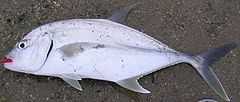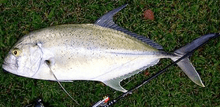Brassy trevally
| Brassy trevally | |
|---|---|
 | |
| Scientific classification | |
| Kingdom: | Animalia |
| Phylum: | Chordata |
| Class: | Actinopterygii |
| Order: | Perciformes |
| Suborder: | Percoidei |
| Superfamily: | Percoidea |
| Family: | Carangidae |
| Genus: | Caranx |
| Species: | C. papuensis |
| Binomial name | |
| Caranx papuensis Alleyne & W. J. Macleay, 1877 | |
 | |
| Approximate range of the brassy trevally | |
| Synonyms | |
| |
The brassy trevally, Caranx papuensis (also known as the brassy kingfish, Papuan trevally, tea-leaf trevally and green back trevally) is a species of large marine fish classified in the jack family, Carangidae. The brassy trevally is distributed throughout the tropical waters of the Indian and West Pacific Oceans, ranging from South Africa in the west to the Marquesas Islands in the east, including Australia to the south and Japan in the north. The brassy trevally is best distinguished by its colouration, having small black spots scattered above and below its lateral line, with a narrow white outside edge to its lower caudal fin. The species grows to a known maximum length of 88 cm and a weight of at least 6.4 kg. It predominantly inhabits both coastal and offshore reefs, as well as inshore lagoons, bays and even estuarine waters as a juvenile. It is a predatory species, moving either individually or small schools, where it takes small fish and occasionally squid and crustaceans. Nothing is known of its reproductive cycle. The brassy trevally is not of great importance to commercial fisheries, but is taken in many netting and hook and line operations throughout its range. It is valued as a gamefish by anglers and spearfishermen, and is considered an excellent table fish.
Taxonomy and naming
The brassy trevally is classified within the genus Caranx, one of a number of groups known as the jacks or trevallies. Caranx itself is part of the larger jack and horse mackerel family Carangidae, a group of percoid fishes in the order Perciformes.[1]
The species was first scientifically described by the Australian zoologists Haynes Gibbs Alleyne and William John Macleay in 1877 based on a specimen collected from Hall Sound off Papua New Guinea which was designated to be the holotype.[2] They named the species Caranx papuensis, with the specific epithet taking its name from Papua New Guinea where the holotype was taken.[3] They referred the species to the genus Caranx, where it has remained. The species was independently redescribed twice; the first by Samuel Garman, who applied the name Caranx regularis and then by J.L.B. Smith with the name Caranx celetus.[4] The species was apparently widely confused with the now dubious Caranx sansun,[5] a move which resulted in Smith trying to resolve the taxon by renaming the species that had been identified as C. sansun,[6] which led to several now defunct junior synonyms.
The species is commonly referred to as the 'brassy trevally', 'tea-leaf trevally' or 'green back trevally' in reference to its colouration, while 'Papuan trevally' is used in reference to the specific epithet.[4]
Description

As its name suggests, the brassy trevally is a brassy to yellow greenish colour dorsally, becoming silvery white on the underside. Juveniles generally lack the brassy tinge, being silver all over.[9] The species head and body above the lateral line is scattered with small black spots, with few spots occasionally much lower near the pectoral fins. These spots become more numerous with age. The species also has a conspicuous pale silvery-white spot with black margins shoulder near the upper opercle. The fins are yellow to dusky with the exception of the caudal fin which has a dusky upper lobe and a dusky to yellow lower lobe and distinctive narrow white band on the trailing edge.[7][8]
Distribution and habitat

The brassy trevally inhabits both inshore and offshore environments, predominantly inhabiting the seaward side of reef complexes or deep water pinnacles as an adult.[11] Other habitats the species is known from include rock outcrops in sandy bays and lagoons,[12] while juveniles are often found in tidal mangrove lined creeks in turbid waters.[13] Juveniles are also found in estuaries throughout their range, occasionally extending to the upper reaches of rivers.[14][15][16]
Biology and fishery
The brassy trevally is a predatory fish, traveling either individually or in small schools, where it hunts down a variety of prey including small fish, squid, prawns and crabs.[11] Studies on the species in Natal estuaries found juveniles take predominantly crustaceans as prey, switching to teleosts as they mature.[14] Other aspects of the species biology are poorly understood, including reproduction and movements, although catch data indicates higher numbers occur in South Africa in summer.[11]
The brassy trevally is not of high importance to commercial fisheries, often finding its way to market as bycatch in various netting and hook and line fisheries.[7] Catch statistics are not kept for the species. The species is of some importance to recreational fishermen, and is considered a good gamefish and is often taken by various fish baits as well as lures and flies.[17] Despite this, it is rarely targeted by anglers, who overlook it for larger relatives such as giant trevally and bluefin trevally,[18] with the species often being an incidental catch, and rarely kept.[19] The species is also commonly taken by spearfishermen. Brassy trevally is considered to be an excellent table fish.[11] The species has been held in large saltwater aquaria, with studies at the Reunion Island Aquarium reporting the species adjusts to aquarium life, but needs a large tank.[20]
References
- ↑ "Caranx papuensis". Integrated Taxonomic Information System. Retrieved 14 April 2009.
- ↑ Hosese, D.F.; Bray, D.J., Paxton, J.R. and Alen, G.R. (2007). Zoological Catalogue of Australia Vol. 35 (2) Fishes. Sydney: CSIRO. p. 1150. ISBN 978-0-643-09334-8.
- ↑ Alleyne, Haynes G.; William J. Macleay (1877). "The Ichthyology of the Chevert Expedition". Proceedings of the Linnean Society of New South Wales 1 (3–4): 261–281. ISSN 0370-047X.
- ↑ 4.0 4.1 4.2 4.3 Froese, Rainer and Pauly, Daniel, eds. (2009). "Caranx papuensis" in FishBase. April 2009 version.
- ↑ Fricke, R. (1999). Fishes of the Mascarene Islands (Réunion, Mauritius, Rodriguez): an annotated checklist, with descriptions of new species. Koeltz Scientific Books. p. 759. ISBN 978-3-87429-411-9.
- ↑ Smith, J.L.B. (1968). "Studies in carangid fishes No. 4. The identity of Scomber sansun Forsskal, 1775". Occasional Papers of the Department of Ichthyology, Rhodes University 15: 173–184. ISSN 0075-207X.
- ↑ 7.0 7.1 7.2 7.3 7.4 Smith-Vaniz, W. (1999). "Carangidae" (PDF). In Carpenter, K.E. & Niem, V.H. The living marine resources of the Western Central Pacific Vol 4. Bony fishes part 2 (Mugilidae to Carangidae). FAO species identification guide for fishery purposes. Rome: FAO. pp. 2659–2757. ISBN 92-5-104301-9.
- ↑ 8.0 8.1 Randall, John Ernest; Roger C. Steene, Gerald R. Allen (1997). Fishes of the Great Barrier Reef and Coral Sea. University of Hawaii Press. p. 161. ISBN 0-8248-1895-4.
- ↑ 9.0 9.1 Lin, Pai-Lei; Shao, Kwang-Tsao (1999). "A Review of the Carangid Fishes (Family Carangidae) From Taiwan with Descriptions of Four New Records". Zoological Studies 38 (1): 33–68.
- ↑ Hutchins, B.; Swainston, R. (1986). Sea Fishes of Southern Australia: Complete Field Guide for Anglers and Divers. Melbourne: Swainston Publishing. p. 187. ISBN 1-86252-661-3.
- ↑ 11.0 11.1 11.2 11.3 van der Elst, Rudy; Peter Borchert (1994). A Guide to the Common Sea Fishes of Southern Africa. New Holland Publishers. p. 142. ISBN 1-86825-394-5.
- ↑ Kulbicki, M.; N. Guillemot & M. Amand (2005). "Ageneral approach to length-weight relationships for New Caledonian lagoon fishes". Cybium 29 (3): 235–252. Retrieved 2009-05-13.
- ↑ Laroche, J.; E. Baran & Rsoandrasana, N.B. (1997). "Temporal patterns in a fish assemblage of a semiarid mangrove zone in Madagascar". Journal of Fish Biology 51 (1): 3–20. doi:10.1111/j.1095-8649.1997.tb02509.x. PMID 9236084.
- ↑ 14.0 14.1 Blaber, S.J.M.; Cyrus, D.P. (1983). "The biology of Carangidae (Teleostei) in Natal estuaries". Journal of Fish Biology 22 (2): 173–188. doi:10.1111/j.1095-8649.1983.tb04738.x.
- ↑ Blaber, S.J.M.; J.P. Salini & D.T. Brewer (1990). "A Checklist of the Fishes of Albatross Bay and the Embley Estuary, North Eastern Gulf of Carpentaria". CSIRO Marine Laboratories Report (Hobart, Tas.: CSIRO Marine). No. 210: 1–23. ISBN 0-643-05032-9. ISSN 0725-4598. Retrieved 2009-03-13.
- ↑ Kuo, S.R.; H.J. Lin & K.T. Shao (1999). "Fish Assemblages in the Mangrove Creeks of Northern and Southern Taiwan". Estuaries (Coastal and Estuarine Research Federation) 22 (4): 1004–1015. doi:10.2307/1353079. ISSN 0160-8347. JSTOR 1353079.
- ↑ Hansford-Steele, B. (2004). African Fly-fishing Handbook. Struik. p. 472. ISBN 978-1-86872-882-4.
- ↑ Knaggs, B. (2008). "12 Rounds with Trevally". In Knaggs, B. Saltwater Fishing (Silverwater, NSW: Express Publications) (58): 72–80.
- ↑ Williamson, P.C.; N.R. Sumner & B.E. Malseed (2006). "A 12-month survey of recreational fishing in the Pilbara region of Western Australia during 1999-2000". Fisheries Research Report (Department of Fisheries, Perth, Western Australia). No. 153: 1–64. Retrieved 2009-05-13.
- ↑ Mulochau and, T.; P. Durville (2005). "A review of the movements of fish held in captivity in the Reunion Island Aquarium over a five-year period". SPC Live Reef Fish Information Bulletin 15: 13–18. Retrieved 2009-05-13.